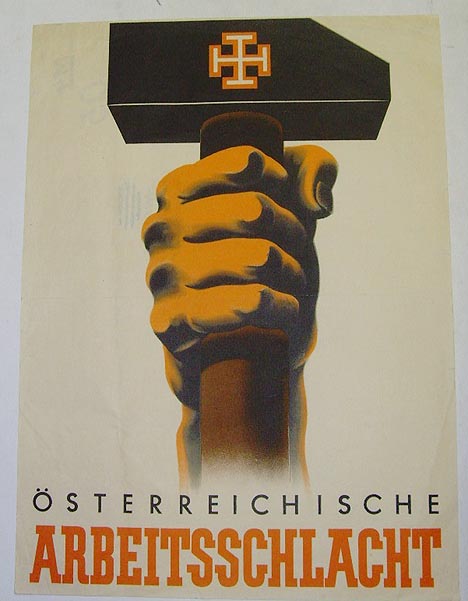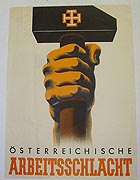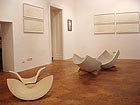
translated and summarized by: Liz Wollner-Grandville,
English summary January 25 - 30
Künstlerhaus Wien: Struggle for the city: politics, art and urban living around the 1930’s
Interwar period: on the loss of the middle
With the exhibition “Struggle for the city: politics, art and urban living around the 1930’s”, the director of the Wien Museum and curator of the show, Wolfgang Kos, attempts to illustrate the socio-political trends of this era. The exhibition tries to mediate the sensitivity and awareness of life of the 1920’s and 1930’s: urban Vienna and its illuminated advertisements, bars, and liberal scripts are set in contrast to the crude right-wing ideologies. Kos chose the year 1930 as a landmark, as it denotes the year in which Vienna was quasi seized by rightist conservative groups. To a large extent, and especially while exploring the sections on the top floor, the exhibition fails to deliver sufficient political facts. Vienna’s special status – federal province since 1921 and governed by Social Democrats, in contrast to the conservative Austrian state government - is merely mentioned. And one only learns about the polarisation and the increasing radicalisation - which is marked by setting fire to the Palace of Justice in 1927 - on a historic timetable positioned on the lower floor. On the day following the acquittal of the three Frontkämpfer (a paramilitary association affiliated with the conservatives), who had killed a child and a war-veteran in Schattendorf, Burgenland, socialist workers set fire to the Palace of Justice on July 15, 1927. As a result, Chancellor Seipel increased his authoritarian anti-socialist course with his Unity List. This was the beginning of the repression of left-wing groups, which eventually led to the civil war in February 1934 and its fatal consequences for Austrian democracy.
One could wish for a stronger accentuation of these events and a more prominent positioning of the historic happenings in 1927. If one chooses to stick to 1930 as a landmark, one should at least mention that 1930 was the last year in which free elections were allowed - for a long time to come. Furthermore, the economic circumstances of the young republic, marred by immense inflation, supported by the Völkerbund (League of Nations), the world economic crisis in 1929, and the collapse of the banks, are all not accentuated strongly enough in the exhibit. After all, these facts formed the economic basis for the socio-political developments that followed.
Works by artists of the Nötscher Kreis, Boeckl, or by Otto Rudolf Schatz, a fervent Social Democrat, with his idyllic images of life at Vienna’s amusement park, the Prater, are displayed on the lower floor. And there are also some rare discoveries to be made: such as “Interrogation” by Friedl Dicker-Brandeis, the artist murdered at Ausschwitz. Shoes, bags, and furniture from the 1930’s are also to be seen, but the exhibited objects give the impression of being souvenirs or trophies from another time.
All in all, a very ambitious exhibit that definitely has a pedagogic character, but: less would have been more. Streamlining the topic would have been advantageous.
By Susanne Rohringer
Künstlerhaus Wien
1010 Vienna, Karlsplatz 5, until 28.03.10
www.k-haus.at
Hamburger Bahnhof – Museum für Gegenwart: Walton Ford – Bestiarium
The Animal time-machine
While viewing Walton Ford’s huge monkey painting “The Sensorium” (2003, 152,4 x 302,3 cm) and keeping European animal paintings of the 19th century in mind, one is reminded of the Gründerzeit painter Paul Meyerheim (1842-1915), whose “Monkey Banquet” is displayed at the Harvard Museum in Boston. The comparison between Ford’s painting and that of Meyerheim clearly points to the parallels as well as the differences of this genre.
Ford, born 1960 in Larchmont in the state of New York, and who now lives in Massachusetts, was fascinated by the works displayed at the Museum of Natural History in New York and by the works created by John James Audubon (1785 – 1851), the famous ornithologist and animal illustrator. With his large-format paintings rendered in the style of his inspirational sources, Ford developed a unique style. Despite being a modern animal painter he is equally determined to depict his objects in great detail, and like the old masters he narrates civilisation- and cultural critical stories with these remarkably large format aquarelle paintings. It is not a coincidence that Ford’s monumental polar bear scene in “Novaya Zemlya Still Life” (2006) resembles Edwin Landseer’s painting “Man proposes, God disposes” (1863-64), which brings Benjamin Franklin’s catastrophic polar expedition back to memory.
The allegoric moment of Ford’s animal paintings cannot be overlooked. The allegory of the battle for survival of the Tasmanian wolf in “The Island” (2009), a painting composed like a triptych, reminds of the extinction of the Australian mammal. The settlers discredited the predator as a “gory hunter” - after they had introduced sheep into the region.
The paintings are set in contrast to historical texts and reports by contemporary witnesses thereby casting an interesting light on the relationship of humans and animals over the course of history. The curators rightfully describe Ford’s work as truly singular in contemporary art. It is undoubtedly remarkable and his paintings, a mixed technique of aquarelle and gouache colours, ink and pencil on paper, surprises with its loosely set brush strokes. Only at a distance do the feathers and fur attain their vitality. But after a while, the question arises whether the artistic media used is really “contemporary”. Does this 19th century form of animal painting offer anything new regarding the condition of our planet? Is the use of an old and tried form of art not falling prey to a mannerist style?
Whatever the answers may be, the exhibition offers unusual insights for all those who are interested in animal depictions and/or contemporary US painting.
By Kai Artinger
Hamburger Bahnhof – Museum für Gegenwart – Berlin
10557 Berlin, Invalidenstrasse 50-51, until 24.05.10
www.hamburgerbahnhof.de
Centre PasquArt: Com&Com – La réalité dépasse la fiction (Reality overtakes fiction)
Post-irony – everything but the past?
“La réalité dépasse la fiction” is the title of the new exhibition of the artist duo Com&Com at the Centre PasquArt in Biel. With this first retrospective after 13 years of cooperation between Markus Gossolt and Johannes M. Hedinger the title postulates that reality has overtaken fiction. The artists sound the bell for their new creative phase on all levels of communication, and the term ‘post-irony’ describes the start as well as the concept of a new artistic strategy - free of all sarcasm and cynicism. “Finally something beautiful” the multi-user-blog “Beiz 2.0” states. All contributions to the blog posted by Com&Com (www.postirony.com/blog), which in the meantime has developed into a diversified collection of pictures, anecdotes, and ideas, deal with Com&Com’s “First Post-Ironic Manifesto”, which, based on the incoming statements, culminates in the formula “Beauty is the new punk”. Post-irony appears in a rainbow garment: it allows all “couleurs” of irony and anti-irony, and encourages and challenges a discourse.
On that note the exhibition is divided into four parts, and naturally the first works are described as “early works” and those following are subsumed as “creative phases”. Without exception, all texts regarding the exhibition consistently pronounce: “in 2009, the art duo will realign itself.” With “Post- irony” the turning point is proclaimed. The demand made by “Dictum. 43 (The only recipe: create beautiful work, then come what may)”, 2001, appears as writing on the wall, and is now delivered in the Salle Poma, the largest room in the Centre PasquArt: here the visitors are confronted with “Tree” (2010) a “Natural Ready Made”. From the roots to its crown, all stages of growth are visible in one object. The tree floats freely in space in a soft dimmed light. The tree is an allegory for a retrospective and can hardly be surpassed by romanticism, symbolism, and closeness to nature. Com&Com not only targets oft-cited formulas of emotion, empathy for recollections or social expectations from the artist, but simulates them: in addition to projects such as the Romanshorn memorial “Mocmoc” (2003 – 2006) wood and ceramic sculptures from the “Ender” (pointer) series (2010) are displayed on white plaster bases or framed pencil drawings. The traditional term of art is questioned with the help of a readily saleable object; the questions are expressed within the communications system of art itself and through its economic structures. But the tree will wither miserably in the museum, while the term ‘post-irony’ is taken out on t-shirts and continues to bloom in the net.
By Marianne Wagner
Centre PasquArt
2502 Biel/Bienne, Seevorstadt 71-73/faubourg du Lac, until 14.03.10
www.pasquart.ch
Galerie Michaela Stock: Stephanie Guse and Karin Sulimma – Fin de Siècle! – den ländlichen Sonnenschein verwursten (processing the rural sunshine)
Resistance in the sunshine
A first and quick glance at the works displayed at the Gallery Michaela Stock by Stephanie Guse and Karin Sulimma does not convey much about the similarities between both artists.
Strands of interpersonal relationships swing in both artists’ installations and photographs. Karin Sulimma’s artistic motif and starting point of her multilayered projects is the lotus flower –as a symbol for time passing by as well as its meaning in Buddha’s teachings. In the two-part sculptures “Lotus Verde” and “Lotus Giallo” she describes the complexity of interpersonal relationships and the confrontation with their environment, using the lotus as a metaphor: while its roots are immersed in mud, it blooms on the surface. Numerous self-contained two-part drawings condense the “Project Lotus” and its multi-layered relationship structures.
Stephanie Guse “processes” the daily sunshine with commercial production methods. In addition to the revised photos showing people from her immediate surroundings, she centres on the current situation of the environment in the installation “Side views, always when I want to throw paper away…”, but always in combination with the aesthetics of industrial throwaway products.
The end of the century – something, which was once seen as a time of change and renewal – seems to last - with its crisis, insecurity and depression. Maybe some rural sun and the reflection on relationships - both towards people as well as the environment - helped.
By Alexander Lass
Galerie Michaela Stock
1040 Vienna, Schleifmühlgasse 18, until 27.02.10
www.galerie-stock.net
Mehr Texte von translated and summarized by: Liz Wollner-Grandville


 Teilen
Teilen





